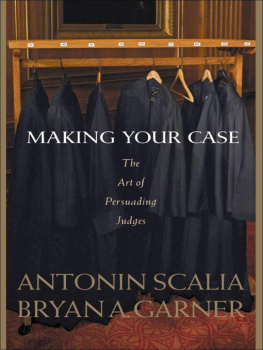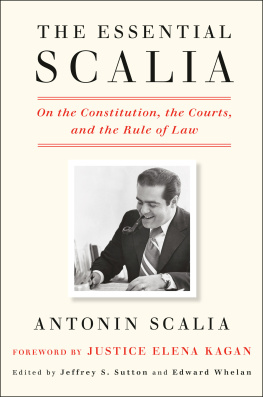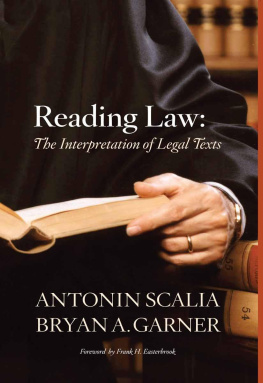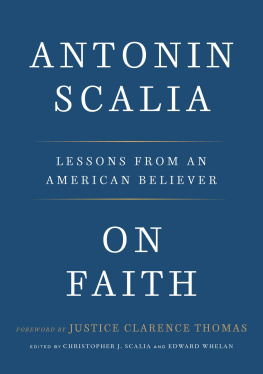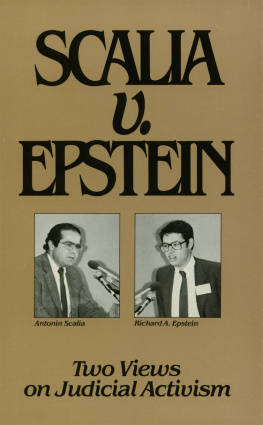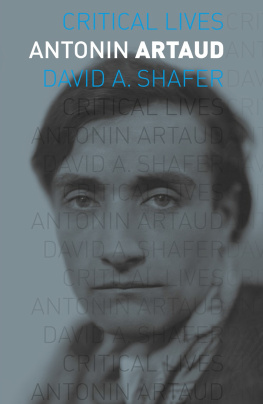Table of Contents
2008 Antonin Scalia & Bryan A. Garner
Published by Thomson/West
610 Opperman Drive
P.O. Box 64526
St. Paul, MN 55164-0527
1-800-328-9352
eISBN : 978-0-314-18471-9
Library-of-Congress Cataloguing-in-Publication Data
Antonin Scalia & Bryan A. Garner
Includes bibliographical references and index.
1. LawUnited StatesMethodology.
2. Appellate procedureUnited States.
3. Oral pleadingUnited States.
4. Legal composition.
5. Forensic rhetoric.
I. Scalia, Antonin, 1936-.
I. Garner, Bryan A., 1958-.
II. Title
Body Copy: Adobe Jenson 13/15
Section Headings: Myriad Pro Semibold 12/14
Inset Quotations: Myriad Pro Condensed 10/10.5
Third printing
Experience is undoubtedly a great teacher, yet it may be counterproductive if what has been cultivated and refined are bad habits. The point is that excellence is the product of the diligent study and application of sound principles, not simply the accumulation of time logged in... courts.
T.W. Wakeling (1979)
Even so:
No rules in the handbooks are capable in themselves of making brilliant performances out of those who intend to dispense with practice and exercise.
Dionysius of Halicarnassus (ca. 30 B.C.)
To our parents
S. Eugene Scalia
(1903-1986)
Catherine L. Scalia
(1905-1985)
Gary Thomas Garner
(b. 1930)
Mariellen Griffin Garner
(1931-1994)
Acknowledgments
During various stages of the development of our manuscript, weve benefited from the generosity of many readers with great experience in our subject:
Hon. Susan Agid
Richard D. Bernstein, Esq.
Hon. Paul G. Cassell
Karolyne H. Cheng, Esq.
Jordan B. Cherrick, Esq.
Charles Dewey Cole Jr., Esq.
Richard M. Coleman, Esq.
Prof. Edward H. Cooper
Prof. Ross Davies
Prof. Michael R. Devitt
Brian J. Donato, Esq.
Prof. William V. Dorsaneo III
David M. Dorsen, Esq.
Hon. Frank H. Easterbrook
Hon. Martin L.C. Feldman
Stephen F. Fink, Esq.
Hon. Arthur J. Gajarsa
Henry Goldberg, Esq.
Carl F. Goodman, Esq.
Michael A. Hatchell, Esq.
Prof. Geoffrey C. Hazard Jr.
Hon. Nathan L. Hecht
Hon. Robert H. Henry
Steven A. Hirsch, Esq.
Tiger Jackson, Esq.
Hon. Edith Hollan Jones
Prof. Susan Karamanian
George M. Kryder, Esq.
Prof. Douglas Laycock
Todd E. Macaluso, Esq.
Paul G. McNamara, Esq.
Brian Melendez, Esq.
Jeff Newman, Esq.
Gloria C. Phares, Esq.
Hon. Thomas M. Reavley
Eugene Scalia, Esq.
Ann Taylor Schwing, Esq.
Hon. Laurence H. Silberman
Joseph F. Spaniol Jr., Esq.
Scott P. Stolley, Esq.
Hon. Jeffrey S. Sutton
Hon. Deanell R. Tacha
Randall M. Tietjen, Esq.
Prof. John R. Trimble
Aaron Van Oort, Esq.
Richard S. Walinski, Esq.
Prof. Sir David Williams
Hon. Diane P. Wood
For their perceptive comments and suggestions, were most grateful.
Copious thanks are also due to Professor Roy M. Mersky of the University of Texas School of Law. He and his incomparable staff at the Tarlton Law Library, especially Jeanne Price and Leslie Ashbrook, proved critically helpful in tracking down background sources for us to consult in our research.
Karen Magnuson of Portland, Oregon, proofread the book in her typically fastidious wayfor which were appreciative.
A.S.
B.A.G.
Foreword
Published advice on how to persuade judges is as old as the profession of judging itself. Its sources include Aristotle, Isocrates, Demetrius, Cicero, and Quintilian. So anything fundamentally new contributed by this small volume would probably be wrong. Our purpose is to make the best earlier advicewith perhaps a few suggestions of our ownreadily available to the modern practitioner and to adapt it to the circumstances of modern American litigation.
Unsurprisingly, respected authorities on the art of judicial persuasion are not always unanimous. Where there is substantial disagreement with our recommendations, we acknowledge it. Indeed, on four salient points, weve acknowledged disagreements between the two of us, leaving readers to make up their own minds, as they inevitably will.
We deal here with both written and oral presentation. Since many points that apply to the one apply equally to the other, we have sought to minimize repetition by presenting preliminary sections dealing with the basics of argumentationknowing your audience, syllogistic reasoning, etc.and then offering separate sections first on brief-writing, stressing the peculiarities of that form, and then on oral argument doing the same.
To lighten the journey, we have adopted a conversational style that includes occasional contractions and remarks more flippant or colloquial than one would normally encounter in legal commentary. The reader who feels that some of these indulgences fall short of the formality and sobriety expected of a jurist should attribute all of them to the other author, and assume that they have been included under protest.
A.S.
B.A.G.
Introduction
Judges can be persuaded only when three conditions are met:
1. They must have a clear idea of what youre asking the court to do.
2. They must be assured that its within the courts power to do it.
3. After hearing the reasons for doing what you are asking, and the reasons for doing other things or doing nothing at all, they must conclude that what youre asking is bestboth in your case and in cases that will follow.
To provide the reasons that will persuade the court to conclude in your favor, you must know what motivates the court, and thats not always easy to discern. To be sure, following precedent is a concern for all judges, especially in the lower courts. So you must always seek to persuade the court that the disposition you urge is required by prior casesor at the very least is not excluded by them.
Beyond stare decisis, however, it becomes a matter of some speculation what motivates a particular judge. In a question of first impression, to be resolved within a courts common-law powers, all judges would agree that the decision must be driven by (1) fairness to the litigants and a socially desirable result in the case at hand, and (2) adoption of a legal rule that will provide fairness, socially desirable results, and predictability in future cases. How much weight a particular judge may give to (1) or (2)or to their subpartsmay vary. But all judges will surely give some weight to all those considerations, and you can be confident that youre not wasting your time in addressing them.
But unconstrained common-law decision-making is an increasing rarity. Courts are usually confronted with interpreting a governing text, whether a constitutional provision, a statute, an agency regulation, or a municipal ordinance. And in these cases, what motivates a judge cannot be so readily determined. Some judges believe that their duty is quite simply to give the text its most natural meaningin the context of related provisions, of course, and applying the usual canons of textual interpretationwithout assessing the desirability of the consequences that meaning produces. At the other extreme are those judges who believe it their duty to give the text whatever permissible meaning will produce the most desirable results. Most judges probably fall somewhere between these two extremes, perhaps adopting the most natural meaning except when policy consequences affect an area that they consider particularly important (e.g., environmental protection or sex discrimination), or perhaps consulting policy consequences only when the most natural meaning is not entirely clear. Unless you know for sure what sort of judge youre dealing with, youre well advised to argue (if possible) both most-natural-meaning and policy-consequences- cum -permissible-meaning.



